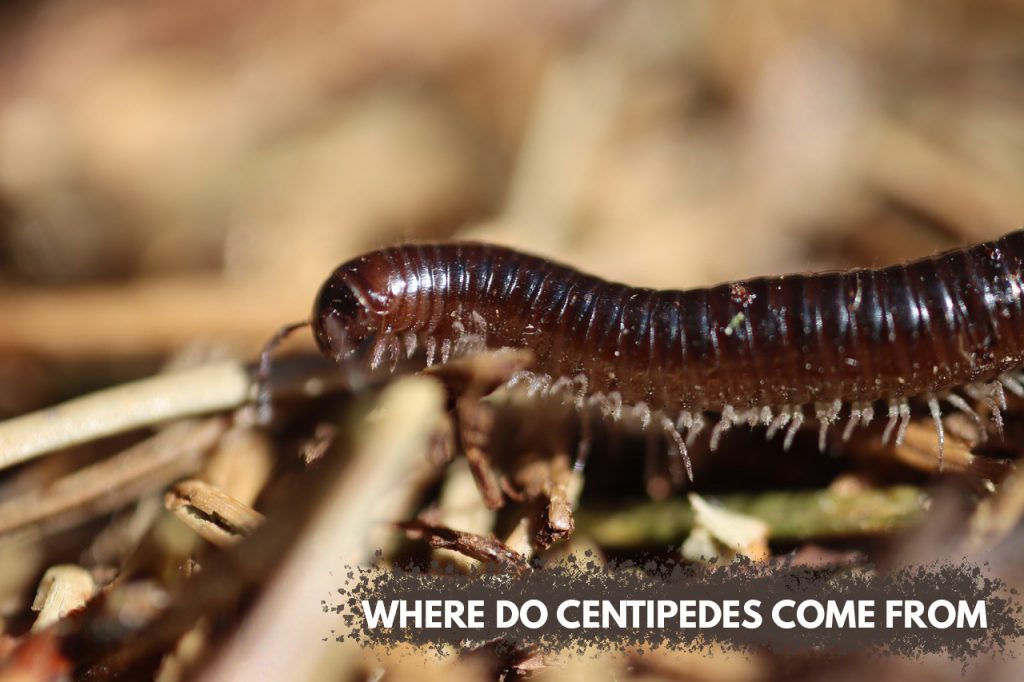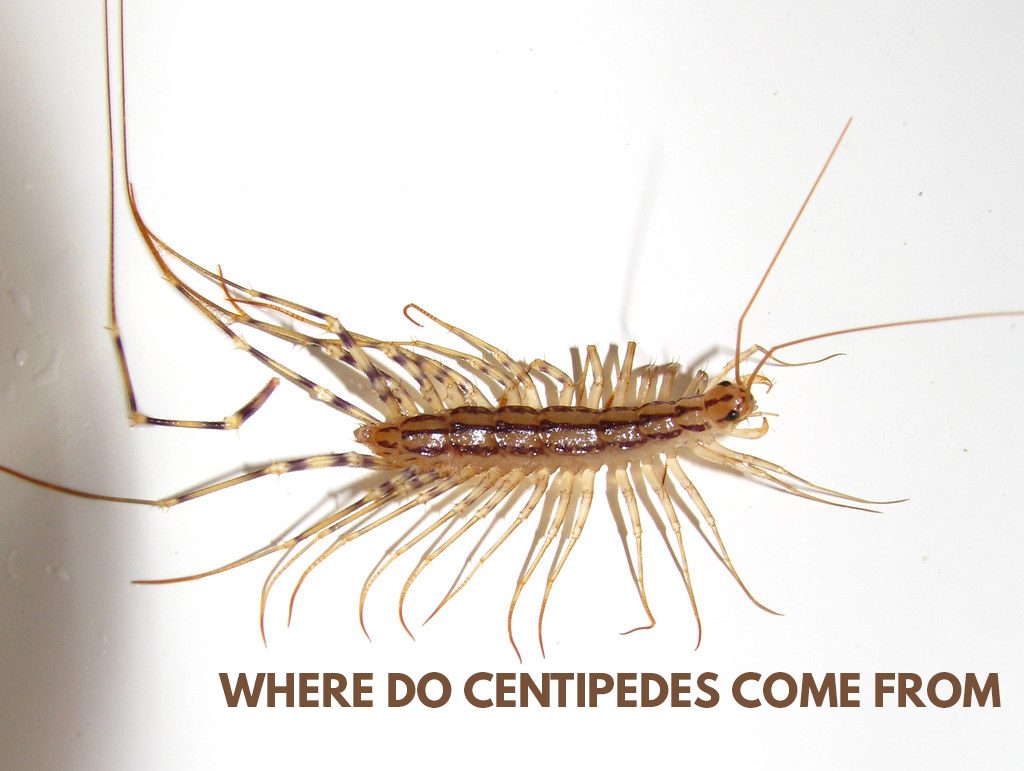This article covers all the aspects of centipedes, like where centipedes come from, how they look, what they eat, and the methods for preventing and killing them. Just keep reading!
What is a Centipede?
A centipede is a tiny insect with many pairs of legs. Depending on their size and habitat, they may have from 15 to 177 pairs of legs. Their size ranges from 4 to 152mm. Due to its many legs, it is often called a hundred-legger. They are found all over the United States of America but are rarely seen. This is strange because they have a very great nocturnal ability and an enormous speed. They have a stripping body of yellowish to dark brown color depending on the area where they are found. Centipedes are elongated and worm-like in their appearance and have an antenna on their head, which allows them to navigate the direction of their prey. Their life span is in the range of one year and not extended to six years.
Habitat of centipedes:
Typically, centipedes are found in high-moisture areas. These areas may include loose bark, rotting wood, under stones, waste, or piles of leaves and grass. They also search damp places like basements, bathrooms, and plants in the house.
What is the source of attraction for the centipedes in your house?

Centipedes come to that house where there are potted plants and a poor drainage system. They think that this house is already the residence of many other insects, so the centipedes enter that house in search of prey and shelter. Sometimes, they also reproduce here if they find the environment of the house safe.
How to avoid centipedes from getting in your house?
The basic rule is to keep your house clean and tidy at all times. If the sewerage system is disturbed, repair it. Clean the damp places and fallen leaves. There should be adequate ventilation in the basements, bathrooms, and other places with a chance of moisture and a humid environment. The holes under your doors and in the windows should be sealed appropriately.
Is the bite of the centipede cause infection?
If they get on your bed and make direct contact with your skin, they surely will sting and leave a swelling and red spot on your skin. There will be no infection, but the pain will be inflicted depending on the tolerance level. But you should go see a doctor if the pain does not go away in two days and is unbearable. Besides, you can get over-the-counter pain medications to relieve pain. They do not bite humans; they sting like a bee sting. Some species have venom in their bite, which they use to kill their prey, like bugs.
What do centipedes eat?
You will be surprised to hear that centipedes are almost blind. They track their food or prey through touch and smell as they cannot see them clearly. They are carnivorous in their food selection and mainly feed on small insects like flies and tiny spiders. As they love swamps and moist places, they also need moisture in their food which they obtain by causing injuries to the plants as they eat the plant tissues.
What is the difference between centipedes and millipedes?
They look very similar in their appearance, but the main difference between centipede and millipede is that the former is a carnivorous species, and the latter is detritivorous or herbivorous. Centipedes eat the moisture parts of plants like leaves, while millipedes feed on the wooden parts. They also feed on the dead or decaying materials of plants. They do not eat flesh at all.
How can I kill the centipedes in my house?

There are some ways to help you kill the centipedes or keep them away from your household items. These are:
- Vacuum cleaner: You can use a vacuum cleaner to kill the centipedes. Move the machine to the area where the majority of them are present. The suction mechanism will suck all the centipedes and clean that area at once.
- Remove the source: You can eliminate the source of attraction of centipedes, i.e., keep the house clean from flies and spiders which they like to eat, and clean the damp places. In this way, centipedes will find your home very unwelcoming.
- Pesticides: These are the chemicals that are used for killing pests. Windex is the name of the best pest killer. It will kill all the centipedes with one spray instantly.
- Scents: There are many different scents that the centipedes find unwelcoming. These scents and their preparation is discussed later in this article.
- Proper disposal: If you get successful in killing all the centipedes of your house but do not dispose of their dead bodies properly, it will attract more centipedes. They love to eat the dead members of their own species.
Epimorphic versus Anamorphic
During several periods of development, centipedes grow their legs. Anamorphic development occurs in the primitive state, represented by Lithobiomorph, Scutigeromorpha, and Craterostigmomorpha, as extra pairs of legs form between molts. For instance, Cutigeral Coleoptera, the home centipede, hatches with just four pairs of legs and grows to sexual maturity with five, seven, nine, eleven, fifteen, and fifteen pairs of legs, respectively, during subsequent molts. The term “lasal Stade” refers to life phases with fewer than fifteen pairs of legs. The now post-larval phases (approximately five more stages) grow gonopods, sensory pores, additional antennal sections, and more ocelli. After that, the total number of legs is reached. The mature lithobiomorph centipedes all have 15 segments that serve as legs.
Ana-morphosis only occurs once in the Craterostigmomorpha, with modules having 15 pairs and eggs having 12 pairs. The clade Epimorphic, which includes the orders Geophilomorpha and Scolopendromorpha, demonstrates epimorphic, in which all pairs of legs are formed during the embryonic stages, and children do not grow other legs in between molts. The longest centipedes belong to this group, and the total capacity of thoracic segments can also vary intra-specifically, frequently according to a species’ geographic range. Typically, women have more limbs than men. The numbers of leg-bearing sections vary greatly, from 15 to 191. Still, because of how they are created during development, pairs are always put together, making the overall number of pairs always odd.
Organic way to keep the centipedes away from your home:
There is a list of scents that are unpleasant to the centipedes. These are:
- The scent of the plant mint
- Tea tree oil
- Peppermint oil
- Rosemary shrubs
- Clove oil
- Thyme oil
- Lavender
- Eucalyptus oil
The scent of the plant mint:
You can plant a mint near damp places in your garden. It will be a source of mint for your margarita and keep those centipedes away.
Tea tree oil:
Add some drops of tea tree oil to the water. Make a dilute solution and spray it on the entrances of your house.
Peppermint oil:
This has dual advantages. Spray the diluted solution of peppermint oil and water it on the leaks and gaps of your doors and get rid of centipedes from invading your house, and your house will smell amazing too.
Rosemary shrubs:
These will be a beautiful addition to your garden. These shrubs are versatile and can be used for so many purposes, just as making bath salts. And the plus point is that they keep the bugs away, including centipedes.
Clove oil:
You can add it to your detergent while cleaning the house. It will make the house pleasant in fragrance and clean from bacteria, fungi, and centipedes.
Thyme oil:
It is readily available in the market. There are two ways to use it; either spray it on the entrances and soak a cotton ball in it and place it on the leaks and gaps.
Lavender:
Its best use is in the bathroom. It will remove any pungent smell and keep the centipedes away. You can use it all over the house. Your house will become welcoming for the guests and highly unwelcoming for the centipedes. While cleaning, you can mop the floor with lavender oil.
Eucalyptus oil:
Cut the branches of the eucalyptus and extract its oil. Dilute it with water and spray it all over the house to keep the centipedes away.
From where does centipede mostly come?
The main areas of importance are as follows:
- Bathrooms
- Garages
- Foundation cracks
- Basements
- Drains
- Attic
- Under clutter
- Gardens
Conclusion:
Centipedes find damp places to invade a house and reproduce. If you want to avoid them, keep the house clean or spray some pesticide at the entrance.
Apart from this, if you are interested to know about What is a spray dryer used for? then visit our BUSINESS category.
Read More: Causes and accessing the molds in the home
FAQs:
Centipede is an excellent species for research purposes. Students mostly search its scientific name, which is Scutigera coleoptrata.
Yes, they do. But they do not jump at you unless you try to kill them. They jump in order to capture their prey mainly.
Turning on the lights is a temporary solution to keep the centipedes away as they do not like to stay in lighted areas. As soon as you turn on the light, they will crawl back to a dark place that they consider safe.

